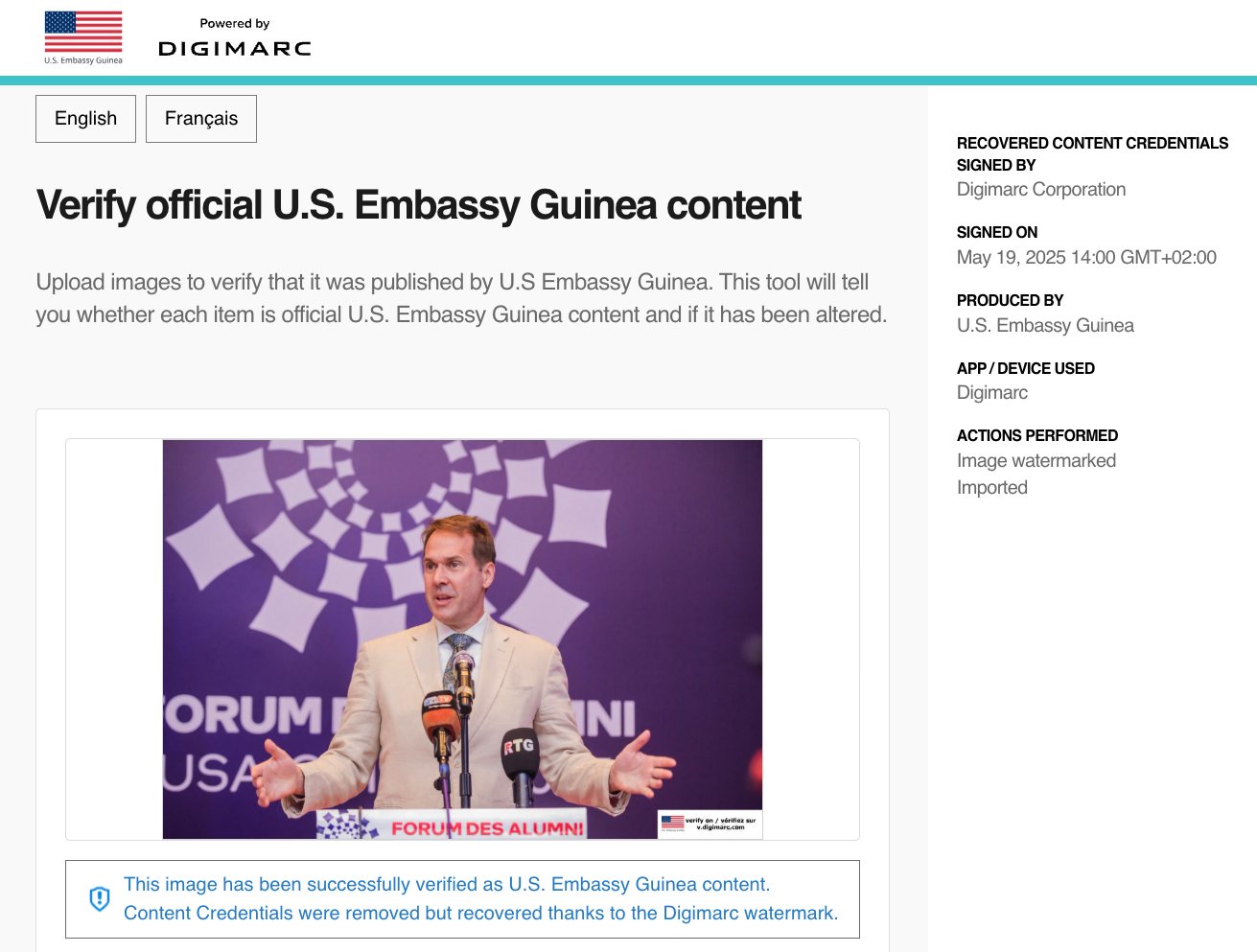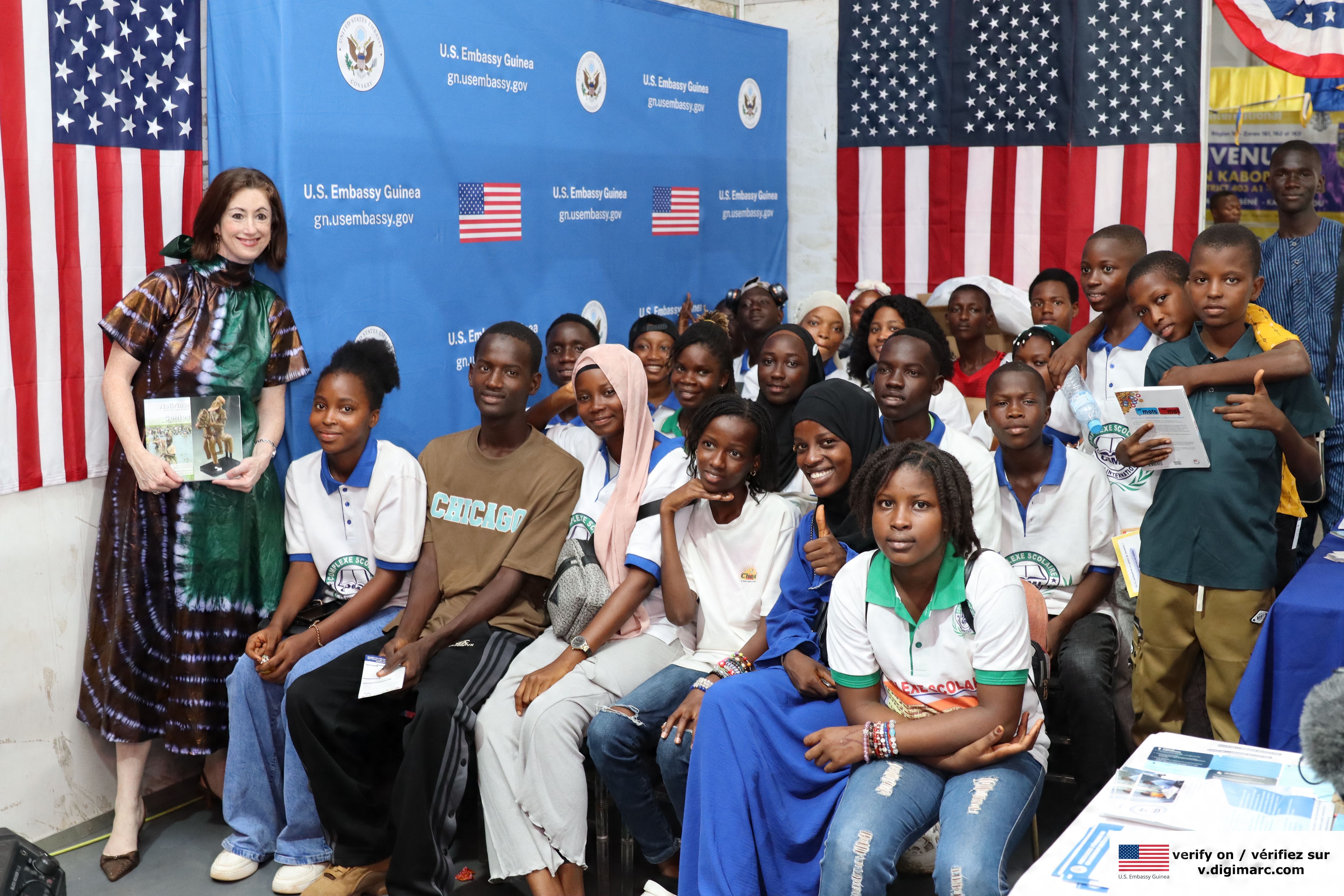How the U.S. Embassy in Guinea fights misinformation with digital watermarks and Content Credentials

The African nation of Guinea is coming online in a big way. It’s seen a 20% increase in internet access over the past decade, cellular mobile and broadband connections are on the rise, and — as of January 2025 — over 20% of the population was actively using social media.
However, while greater connectivity brings exciting possibilities for communication and connection, it can create challenges as well. Many people who are new to the internet lack the digital literacy skills to discern fact from fiction online, making them vulnerable to misinformation and manipulated media.
The U.S. Embassy in Conakry, Guinea, is particularly concerned about misinformation. Early this year, deepfake videos circulated online falsely depicting the French Ambassador and Guinean political leaders in compromising situations, and another viral video falsely claimed that U.S. forces were training Guinean security forces to attack civilians. As a result, Embassy leaders decided they needed to proactively secure the integrity of their communications.
They partnered with Digimarc, a global leader in identification and authentication solutions, to launch an initiative aimed at fighting digital disinformation. By embedding Digimarc’s invisible digital watermarks and C2PA Content Credentials into all images of U.S. officers shared on social media, and by creating an online tool that allows anyone to upload an image and verify its provenance, the Embassy is empowering Guineans to identify what’s real and restoring their trust.
We recently spoke with Dom Guinard, Content Authenticity advisor at Digimarc and co-chair of the C2PA Watermarking Task Force, to learn more about what might be the most robust and accessible content verification system ever deployed in a developing nation.
This interview has been edited for length and clarity.
You co-chair the C2PA’s Watermarking Task Force. What does that work entail, and why are watermarks so important to the durability of Content Credentials?
The goal of the task force is to create a framework so that all watermarking and fingerprinting technologies can interoperate, allowing a client or implementer to have a single way of working with different technologies, regardless of who provides them. That’s really our north star.
The idea of digital watermarking as part of the C2PA standard is to make Content Credentials “stickier” or more durable. Content Credentials’ metadata tends to be stripped off by different tools, either maliciously or not. Non-malicious removal is the primary use case — a tool could be trying to protect privacy by removing this metadata, or it could be removed for other reasons.
The goal of the watermark is to create a strong link between the Content Credential and the asset itself, so that the metadata is not only attached to the asset, but there's also a link from the asset — either from its pixels, or in the case of an audio track, its bits — to the C2PA manifest.
Tell us about the U.S. Embassy Conakry verifier. How does it work?
The idea of the verifier is to allow Guineans to check if content that they saw online really came from the Embassy. Internet access for Guineans is ramping up very quickly and so is the rate of AI generated content that might be misleading. With this tool, they can check the authenticity of Embassy content themselves. The Embassy has had a few incidents where content was counterfeited, and so that’s what sparked this idea of creating a verification tool supporting the C2PA standard.
How do Guineans engage with the internet right now? Are they limited to certain platforms?
It's very mobile-oriented. Facebook is a major source for information in many places, but especially in Guinea. A lot of news and information comes from social networks, and those social networks unfortunately strip off Content Credentials.
How does the Embassy apply watermarks and Content Credentials to its photos?
During the pilot, they used a tool that Digimarc designed for them to apply Content Credentials and a watermark before publishing the content on social media. They did not use it on all images — primarily on those that contain U.S. diplomats and officials.
Did you use any of the CAI’s open-source tools to develop the verifier? What were some of the challenges you encountered?
We used a number of the CAI open-source tools: c2patool, the c2pa-js library, and the Rust libraries. They were really helpful in accelerating the implementation, and we really like them and value them.
For us, the implementation challenges were less technical and had more to do with the UX. Since the users would primarily be on mobile phones, how would they verify something on Facebook? On a computer, you could verify something in a browser using one of the Chrome extensions that are out there, like Digimarc’s open source C2PA extension or the Adobe Content Authenticity extension. But on a mobile phone, you can't.
You also can't point your phone at your phone. Digimarc has a mobile app where you can just point your phone at another asset and it detects the watermark and restores the C2PA manifest, but that’s not possible when you use your phone to access the content.
So how do you get people to verify when they're on a social network on mobile? We solved for that by making the verifier mobile-first and mobile-friendly. There’s also a call to action on the Embassy assets that was added as a visible watermark that prompts you to browse to the verifier.
The Embassy also ran a campaign called “Verify Before You Share,” where they explained the whole process. Essentially the user has to download the asset, go to the verification page, and upload it there. It's not the best user experience — it would be better if C2PA was directly integrated into the mobile browser, or any browser for that matter.

Do you foresee future iterations of this implementation as a mobile browser integration?
I really hope so, but the problem is in the mobile platform itself. You can't easily build a mobile browser extension, so the C2PA standard would need to be integrated by the mobile browser developers or by the social networks themselves for the user experience to be seamless. I certainly hope this will happen, because that would be a turning point for the C2PA.
Adobe and Digimarc previously demonstrated interoperable and durable Content Credentials in a first-of-its-kind partnership. Can other C2PA inspection tools surface the Content Credentials and Digimarc watermarks on U.S. Embassy Conakry images, and can the Conakry verifier surface Content Credentials and watermarks applied to images using other tools, like Adobe Content Authenticity?
Thanks to that demonstration with Adobe, you can find a C2PA manifest based on a Digimarc watermark or based on an Adobe TrustMark watermark, using either Digimarc’s or Adobe’s demonstration verifier.
In the particular case of this Embassy verifier, it existed before the integration of the two technologies. So the verifier does not look for watermarks other than Digimarc’s at the moment. But this is really what the task force has been working on in trying to create a standardized process. Following the C2PA 2.2 specification, it is possible to have a verifier that just works across the board of all supported watermarking technologies.
The Embassy verifier will still validate C2PA Content Credentials on photos that were not watermarked by Digimarc, and it will communicate that the content is valid but that it didn’t come from the Embassy. That statement of whether or not an image came from the Embassy is something that the Embassy specifically wanted to include.
What led you to work with the U.S. Embassy in Guinea in particular? What were some of your goals, and have you seen any impacts since the partnership began?
They actually reached out to us. They were really at the forefront of trying to resolve the problem of falsified images, and they heard about the C2PA. Interestingly enough, they understood that it was a great solution, but prior to having the watermark option or the soft binding, it wasn't really working for them. They knew that most of the traffic from Guineans regarding the Embassy was coming through Facebook, and today, Facebook strips Content Credentials from files.
When they heard there was a group working adding watermarking to the standard to make Content Credentials durable, they reached out to us and asked whether we could launch a pilot to see if this would work. The idea of the pilot was then to basically establish a proof of concept for the Embassy to show that this was feasible. There have been positive comments about the tool on the Embassy’s social media, and it seems to have been well-received.
How do you see Digimarc scaling this implementation? What other institutions would you like to partner with next?
We're definitely interested in scaling these types of projects with governments, media companies, or, more generally, content creators. One of the barriers is still the native adoption of the C2PA standards into commonly used tools like mobile operating systems or mobile and desktop browsers, because while it works and has been getting good feedback, the user experience is still not as good as it could be. We need the social networks, the mobile platforms, and the browsers to support C2PA and the watermarking recovery natively. Having said that, adoption has ramped up very quickly over the last two years, and I’m confident we’ll get to mass-scale adoption soon.
Do you have any plans for implementation in video?
Aside from still images, Digimarc has been pretty active in audio watermarking for many years, including watermarking the audio channel of videos. More recently, our watermarking research team has also been working on a pure video watermark offering and we’d be delighted to test it with prospects.
Anything else you’d like to share?
While the potential of generative AI is undeniable, it is also creating its own set of issues. Some of these problems, such as the one covered by this pilot, are already pretty acute. Ultimately, this type of verification process is not just a toy — it's a tool that will help us to remain critical and allow us to verify what we see online. Just like we have nutritional facts for the food we eat, we need content provenance for the content we consume.